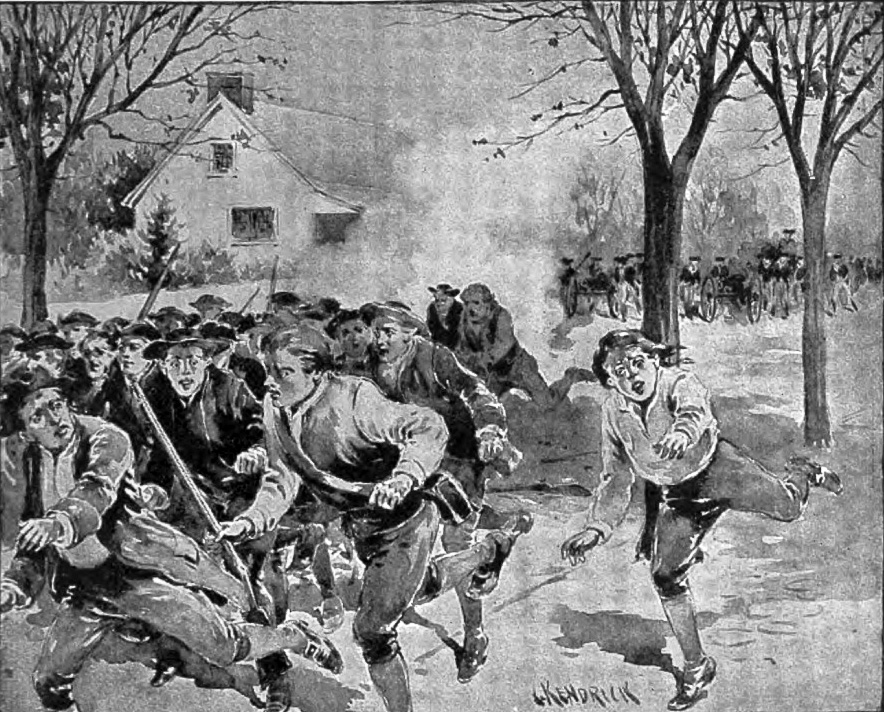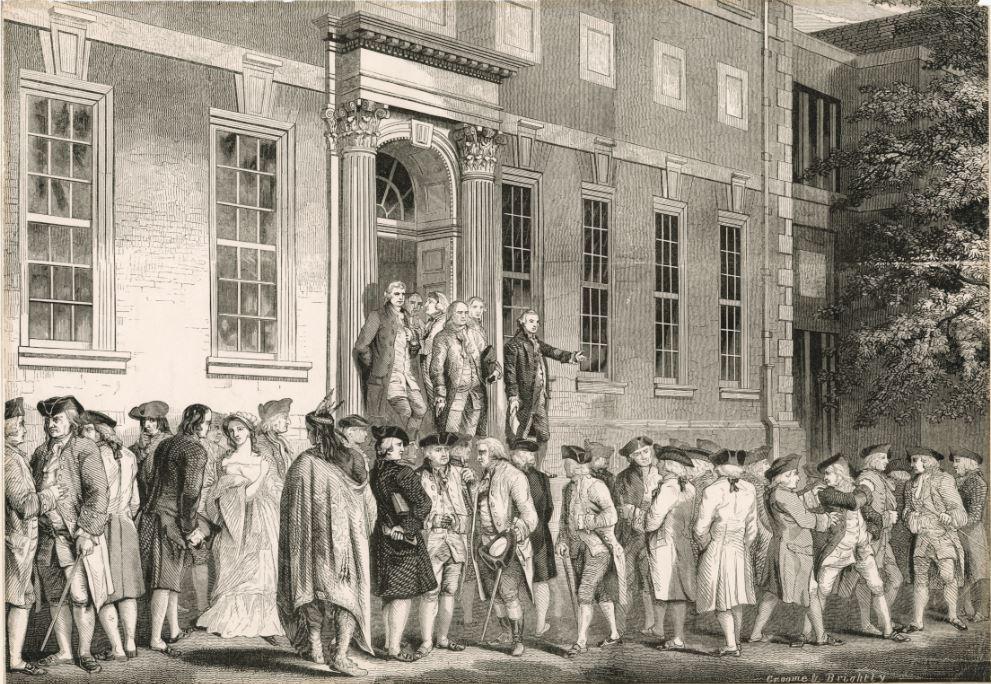Hello everyone, Scarce here with another double post. This time, it's an update though, so I hope y'all enjoy!
The Second Constitution is Signed
A most Abhorrent Violence: The Death of the First American Republic by August H. Drake. USA, 2037.
The rest of the United States was not idle as the Regulators continued their rampage across New England. On June 3rd, the same day as the second Battle of Springfield, an assembly of representatives of New York, New Jersey, Pennsylvania, New Hampshire, Connecticut, Rhode Island and the Cushingites of Massachusetts agreed to establish an army that would be jointly funded and manned by the aforementioned states with the sole purpose to throw the Regulators back. Major General “Mad” Anthony Wayne was made head of the combined army.
Wayne would commit tremendous efforts towards assembling the joint army, however, he would be hampered at every turn as rumors of Regulator plots caused New York and New Jersey to withhold significant amounts of men and material to protect themselves, while Rhode Island and Connecticut would fall to Regulator control and only exiled remnants would become a part of the joint army. Throughout August, the paranoia of New York would be proven correct as a series of small revolts would break out in the norther part of the state, sapping further from the planned pushback against the Regulators. Through July and August, the joint army would languish due to the various issues, but by September, things were looking up for the joint army. Supplies, funds and manpower began to flow into the joint army as the states began to fear an eminent invasion as the Regulator’s successfully united their governments into one.
And then, on September 28th, all hell broke loose for the Second Constitution of the United States was finally finished, and the Republic entered its death throes.
The First Constitutional Convention from ITTS:usa.was.americanhistory.gov, 2042
The 137 days of the First Constitutional Convention were perhaps the most important days in the whole of the Empire of the United States of America’s history despite the Second Constitution having been used exclusively before the actual declaration of the Empire. It successfully stabilized the fledgling United States, and while it did contribute some to the escalation of the growing Regulator Rebellion, the new Constitution was successful in preventing the nation from disintegrating due to the Rebellion. While the stabilization of the United States was the most immediate effect in the long term, the ideals of the Second Constitution’s proved to be the most important aspect of the Constitution. All succeeding Constitutions, regardless of their actual content, claimed the ideals of the Second Constitution.
On May 14th, 1787, the First Constitutional Convention officially began, although the required quorum of seven states wouldn’t actually be met until the 23rd. The remaining six states would see their delegates arrive later, with Rhode Island’s delegation only departing after the state was overrun by the Regulators in July. [1] One of the first acts of the delegates was to elect General George Washington as President of the Convention. In many ways it was Washington who would allow for the Convention’s success, his respected name and capable leadership kept the Convention united and may even have prevented the Convention from failing. [2]
The beginning of the Constitutional Convention saw a rejection of the initial plan to revise the First Constitution, the Articles of Confederation. Instead, the beginning of the Convention saw a series of plans be floated by the delegates. The first plan, the Virginia Plan, was drafted by James Madison and proposed by Edmund Randolph. The Virginia Plan called for a very powerful bicameral legislature, with a lower house that was elected popularly and proportioned by population, and an upper house elected by the lower house. A weak executive would exist, solely to enforce the legislatures will, and a judicial branch with a limited veto would also be created. The delegates from many of the smaller states however disliked the proposed system of proportion by population, fearing domination by the larger states, and thus threw their weight behind a second plan: the New Jersey plan. Proposed by William Patterson, the New Jersey plan resembled the First Constitution, proposing a unicameral legislature where every state would have equal representation, although in contrast to the First Convention an executive would be created as well as a judiciary.
James Maddison William Patterson
As the two plans were debated, the Regulator Revolt continued to escalate, prompting some to fear that the proposed plans would simply not create a government that would be strong enough to protect against internal unrest. Foremost among those who believed this was Alexander Hamilton. Hamilton would create a third plan, the Hamilton Plan, which would be the first proposal to end the republic and establish a monarchy. [3] The Hamilton Plan would call for a bicameral legislature with an elected lower house, and an upper house elected by electors. An elected monarch would serve as the executive, with the monarch being elected by the upper house. [4] The plan was a radical departure from what was generally accepted to future of the United States, and while considered well designed by all delegates, the plan truly only saw small level of support when it was first proposed. However as the Regulators continued to advance, more and more support was thrown behind the Hamilton Plan, leaving the Convention in a three-way deadlock that may have ended it had it not been for the Great Compromise.
The Great Compromise was a plan devised by four men: Roger Sherman, Daniel of St. Thomas Jenifer, Nathaniel Gorham and Oliver Ellsworth. Working outside of the Convention in private, the four men each held far-differing beliefs that allowed them to unite the three plans. The Compromise Plan called for a bicameral legislature, with a popularly elected lower house that would be proportioned by population, and an upper house that would be appointed by the state governments, with each state receiving equal representation. The executive would be a three-person affair, with a monarch and two other executives, all of whom would share equal power. [5] A judicial branch, with explicit powers to render federal laws null and void would be created as well, with judges being appointed by the executives. [6] Another provision which was explicitly proposed in the plan was that the states would have full control over all powers not granted to the federal government and have the rights to decide whether or not the state would be a republican or monarchical government. While the Compromise Plan satisfied none of the delegates, when the plan was put forward before the Convention on July 5th, it narrowly managed to come out as the working plan for the Constitution. [7]
Over the next two and a half months, the remaining elements major elements of the Second Constitution would be added. In order to placate many of those who were still concerned that the new monarchy would establish a tyranny, a Bill of Rights would be integrated into the Second Constitution and a proposed “necessary and proper” clause was nixed. [8] Issues involving slavery were frequently argued during the Convention, with another element of critical importance was added. Pro-slavery delegates from the South pushed for significant concessions, threatening that they wouldn’t even join if the new federal government had the authority to interfere with slavery. Anti-slavery elements however found many of the demands to be unwelcome and extremely distasteful, and while a few concessions, such as a proposal to allow 3/5ths of the slave population to be counted as representation in the House of Representatives had been made previously, the debate remained as contentious as ever in July. On August 16th, a series of proposals were made by John Dickenson and Charles Pinckney that largely resolved the situation. Slavery and the international slave trade were not to be touched by the federal government until 1818, at which point the federal government could begin the process of compensated emancipation that was to take “no more than thirty years.’ In order to sell this to the pro-slavery faction, the full slave population was to be counted for representation, export taxes were to be fully banned, and import taxes would require two-thirds approval by Congress. Even still, and despite Charles Pinckney throwing his weight behind it, the proposal faltered. However, it was at this point that Washington broke his otherwise stalwart impartiality and spoke up in support of the proposals. Washington’s support, along with an agreement that the national capital would be place north of the Mason-Dixon line, finally propelled the proposals to passing. [9] Despite their extremely contentious nature, the issues surrounding slavery were ultimately amongst the least important in the long term as the Third Constitution would override the bulk of them when it was established in 1842. [10]
With the largest of the issues resolved, the remaining period saw many smaller issues be debated as the Committee of Detail finished drafting the body of the constitution, and the Committee of Style piece together all of the various details into a cohesive document. On September 21st, the final draft of the Second Constitution was complete, and three days later adopted by the Convention. The Constitution ultimately pleased none of the delegates, but as Benjamin Franklin would go on to say: “Considering our current situation, I doubt too whether any other Convention we can obtain, may be able to make a better Constitution.” Ultimately forty-three of the sixty-one total delegates [11] would sign the Constitution that would be published for the whole of the United States to read on September 28th. While the Constitution called for ratification by all of the states through their own individual ratification conventions, due to the situation, the Congress of the Confederation could temporarily ratify the Constitution until each of the states could hold a ratification convention themselves. Thus, the Second Constitution came into effect on October 3rd as the Congress of the Confederation unanimously voted to ratify the Second Constitution…
[1] Rhode Island didn't attend OTL, but given the circumstances, the exiled government likely would have sent representatives.
[2] All per OTL
[3] IOTL Hamilton proposed what was in effect called for an elective monarchy, so the Hamilton Plan is largely his OTL proposal re-branded. It's doubtful Hamilton was a monarchist IOTL, and even ITTL he really isn't an actual monarchist but instead is using the idea to advance his ideas. Of course, he won't be characterized that way ITTL because his proposal forms a monarchical government.
[4] All Hamilton's OTL plan.
[5] Most of this is OTL as well, of course with the addition of an elected monarch to the compromise. To avert fears of establishing a tyrannical monarchy, the two executives (Directors) are added which makes the monarchist government actually resemble some of OTL's most outspoken anti-monarchists proposals as they too proposed a multi-person executive.
[6] The Judiciary has the precedent set by Marbury v. Madison from the get go in this proposal, likely to give extra assurance against tyranny.
[7] Like most compromises, nobody's particularly happy, but they can
tolerate it for the good of all.
[8] IOTL three members of the Convention, Elbridge Gerry, George Mason and Edmund Randolph attempted to get a Bill of Rights in during the Convention but the proposal failed. ITTL the Convention is more acceptable.
[9] In OTL, the Capital was placed as close to the north as it could while still being considered a southern city so ITTL the capital will be as far south as it can be while still being north of the Mason-Dixon line.
[10] I know this makes it seem like slavery ends peacefully, but that isn't strictly speaking true.
[11] Similar ratio to OTL.




